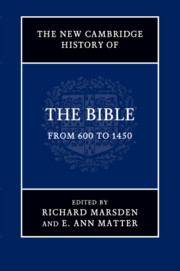Book contents
- Frontmatter
- Contents
- Figures
- Contributors
- Preface
- Abbreviations
- Abbreviations of books of the Bible
- Table of Psalm numbering
- Introduction
- Part I Texts and Versions
- Part II Format and Transmission
- Part III The Bible Interpreted
- 26 Byzantine Orthodox exegesis
- 27 The patristic legacy to c. 1000
- 28 The early schools, c. 900–1100
- 29 The Bible in medieval universities
- 30 Scripture and reform
- 31 Jewish biblical exegesis from its beginnings to the twelfth century
- 32 The Bible in Jewish–Christian dialogue
- 33 The Bible in Muslim–Christian encounters
- Part IV The Bible in Use
- Part V The Bible Transformed
- Bibliography
- Index of biblical manuscripts
- Index of scriptural sources
- General index
- References
27 - The patristic legacy to c. 1000
from Part III - The Bible Interpreted
Published online by Cambridge University Press: 28 May 2012
- Frontmatter
- Contents
- Figures
- Contributors
- Preface
- Abbreviations
- Abbreviations of books of the Bible
- Table of Psalm numbering
- Introduction
- Part I Texts and Versions
- Part II Format and Transmission
- Part III The Bible Interpreted
- 26 Byzantine Orthodox exegesis
- 27 The patristic legacy to c. 1000
- 28 The early schools, c. 900–1100
- 29 The Bible in medieval universities
- 30 Scripture and reform
- 31 Jewish biblical exegesis from its beginnings to the twelfth century
- 32 The Bible in Jewish–Christian dialogue
- 33 The Bible in Muslim–Christian encounters
- Part IV The Bible in Use
- Part V The Bible Transformed
- Bibliography
- Index of biblical manuscripts
- Index of scriptural sources
- General index
- References
Summary
Introduction
Perhaps nothing is more striking to the historically minded observer at the dawn of the twenty-first century than to note the continuing significant impact of ancient religious writings on modern life. In a world of rapidly increasing and ever more powerful global technologies that were unimaginable just a decade or two ago, in a world whose peoples have never been more highly educated or more closely linked to one another around the planet, in a world of space exploration, nuclear energy, stem cell research and sophisticated new understandings of nature and of the human mind and body, the importance of ancient religious thought to modern individuals and their communities provides a powerful example of vibrant historical continuity. How is it that writings composed by ancient peoples in remote times still speak very powerfully to modern people and modern societies?
By the end of the patristic age, roughly the middle of the fifth century ce, the Hebrew Bible had developed masoretic, Samaritan and Greek forms and with the diaspora of the Jewish people had spread to many places in the Mediterranean world. Still, this was a small community of readers and listeners. The growth of Christian communities in the ante-Nicene and patristic ages provided new audiences for the Hebrew Bible since Christianity appropriated Hebrew scripture as the foundation for its own scriptures and core beliefs. Yet, with the vast transformation of the Roman world accelerating just as Augustine of Hippo died in Vandal-besieged Hippo (430), Christian scriptures spoke in a fragmented, disjointed way to scattered Christian communities around the Mediterranean littoral. The revelations that would eventually take written form as the Qurʾān were still on the distant chronological horizon at the close of the patristic age.
- Type
- Chapter
- Information
- The New Cambridge History of the Bible , pp. 505 - 535Publisher: Cambridge University PressPrint publication year: 2012
References
- 4
- Cited by

